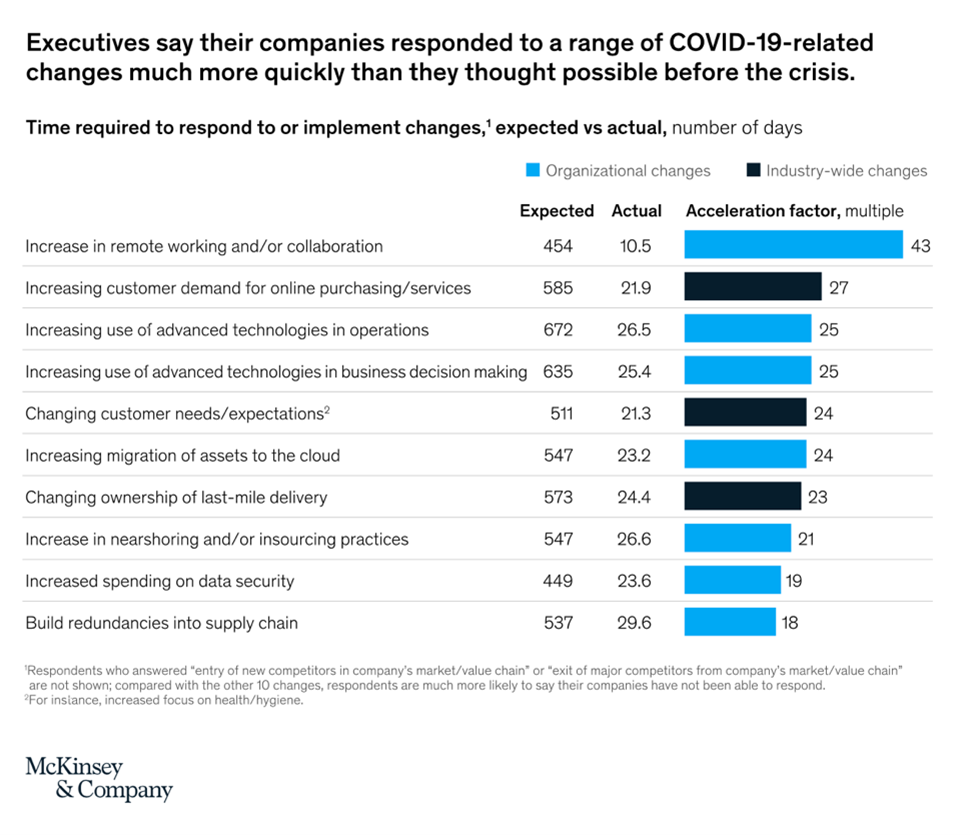
Even though we are not yet out of the grip of the COVID-19 crisis, it is already clear who the winners in business are. Broadly speaking, those organisations with built in flexibility, that were able to innovate, take opportunity where threat existed and utilise their infrastructure to do it, have done well; achieving in months what would normally take years. A lot of this success could be put down to those organisations having effective business continuity strategies.

About the Author
Senior Account Manager, Jeffrey Magara helps Global Enterprise & SME clients to deliver consolidating, cost saving IT solutions and projects.
According to a McKinsey Global Survey in 2020 of executives, these companies have accelerated the digitization of their customer and supply-chain interactions and of their internal operations, by three to four years. And the share of digital or digitally enabled products in their portfolios, has accelerated by a shocking seven years.
Obviously, there were some industry sectors that were better placed than others, especially those involved in e-commerce, who had the capacity and power to access stocks. Moving away from the headline winners though, there are organisations that have managed, through their digital infrastructure, to survive the drastic measures of lockdowns, which saw their workplaces deserted and a paradigm shift to remote working. Based on research carried out by McKinsey, companies that are involved in manufacture have changed the least, regardless of whether they are in B2C or B2B. The companies that have embraced and developed their digital portfolio have been in healthcare, pharma, financial services and professional services.
Scalable organisations, that invested and accelerated digital technologies, such as cloud, have shown a remarkable turn of speed against predicted time. The following graph from McKinsey demonstrates not only the impressive speed of adoption, but the key areas that have been invested in:

Embracing cloud technology
The term ‘scalability’ offered by cloud computing is often banded about, but what are the real-term benefits of having this resource in-place? To put it in very basic terms, it has meant that those enterprises who had adopted a cloud infrastructure, were able to respond to the increased demand swiftly, meaning the difference between coping with the demand and their website being shut down because it was unable to handle the un-precented volume.
The benefits of cloud infrastructure have allowed enterprises to order more stock quickly and pack it and despatch it more swiftly. Having that ability to increase capacity and speed, when needed, could be the difference between thriving or … not!
It also allows enterprises to experiment with new products/services, shortening ‘time to market’ to days and enabling versatility to switch on and switch off when needed. According to a Centrify survey carried out in Autumn 2020, 51% of business leaders stated that the shift to cloud computing has saved them from collapse during the pandemic. Given this success, 60% also said that they are planning to substantially increase their cloud infrastructure as we move hopefully out of the pandemic.
Remote working has been one the biggest successes during the pandemic and probably caught the most media attention, justifiably. Customer service departments that switched to remote working were able to do so and deal with increases in demand from customer calls, as well as still being able to process industry compliant payments. Remote working of this type has also allowed enterprises to offer an increase in customer service, sometimes moving to a 7-days-a-week model, which wasn’t previously viable. Due to the relatively low-cost entry points, remote access has allowed even small companies to collaborate and remain operational, despite being geographically distant; still having access to critical software and shared collaborative tools. I am sure, if remote working strategies weren’t in organisations business continuity planning before, they certainly will be now.
Using data to drive decision making
Being a data driven organisation can bring many benefits, including effective and improved decision making, proactive responses to customer needs and the imperative ability to stay ahead of the competition with innovative ideas and methods. Nothing new there, I hear you say, however, the sheer time and cost of collecting these insights into your business can be crippling, not to mention very time consuming. Alongside this, the sheer volume of data from varying sources, some incomplete, means data may only be used to back up an opinion for decision making, rather than as a main driving force for change. We haven’t mentioned the cultural barriers, where data isn’t accessed and acted upon consistently.
Cloud services are playing a crucial part in making data-based decisions a reality, and one which is bringing great advantage to those enterprises that leverage it. They allow accessibility and response to immediate business demands for data and analytics. What’s more, they provide a level of skills not often present within the enterprises, to be able to keep pace with big data analytics innovation at a much lower cost.
For enterprises wishing to get started in analytics, the Software-as-a-Service (SaaS) route may be a good place to start, offering scalability for multiple users, ongoing software updates, and maintenance. This can be extended to add further value by taking on Platform-as-a-Service (PaaS), to build custom applications. With PaaS, the provider is able to deliver a solution stack integrated set of software, providing an enterprise’s developers with tools to build an application.
The power of this data analysis cannot be underestimated, with enterprises who have adopted this approach able to constantly analyses data from many customer touch points and roll out a campaign in real time, based upon that data.
Key benefits of SaaS Analytics:
• No requirement to have inhouse expertise and capacity
• The ability to rapidly scale storage and compute requirements
• Significant cost reductions compared with inhouse solutions
Ensuring resilience with well thought out and tested Business Continuity (BC) and Disaster Recovery (DR) plans
The possibility of organisations being subject to cyberattacks that can cripple a business or permanently destroy its IT systems, are very much a reality these days. Despite the many advantages of cloud infrastructure, digital transformation and hyper-convergence creates unintended gateways to risks, vulnerabilities, attacks and failures. As part of an enterprise’s Business Continuity and Disaster Recovery plans, a cyber resilience strategy is essential, that can support a business to withstand disruptive cyber incidents. Such plans often include ways to defend against those risks, protect critical applications and data, and recover from breach or failure in a controlled, measurable way.
Today, many enterprises struggle to evolve their resiliency strategies quickly enough to tackle today’s hybrid IT environments and changing business demands. The reality of our always-on 24-7 world, is that enterprises can often gain competitive advantage, or lose market share, depending on how their IT resources serve their core business needs.
Business Continuity Management Services are one possible solution for enterprises to protect their business, by identifying and addressing resiliency synchronisation between business processes, applications and IT infrastructure. This kind of service can provide flexible business continuity and disaster recovery, consulting to address a company’s needs – including assessments, planning and design, implementation, testing and full business continuity management.
With the growth of cyberattacks, enterprises are moving from a traditional/manual recovery approach to an automated and software-defined resiliency approach. This method uses advanced technologies and best practices to help assess risks, prioritise and protect business-critical applications and data. These services can also help business rapidly recover IT during and after a cyberattack.
An alternative path could be to opt for cloud-based backup services; Disaster-Recover-as-a-Services (DRaaS), to provide continuous replication of critical applications, infrastructure, and data and systems for rapid recovery after an IT outage.
There are also virtual server options, to protect critical servers in real-time. This enables rapid recovery of applications to keep businesses operational during periods of maintenance or unexpected downtime.
Along the lines of the above solutions, the answer is with resiliency orchestration; a cloud-based approach that uses disaster recovery automation and a suite of business continuity management tools, designed specifically for hybrid-IT environments. This approach helps protect business process dependencies across applications, data and infrastructure components. It increases the availability of business applications, so that companies can access necessary high-level or in-depth intelligence regarding Recovery Point Objective (RPO), Recovery Time Objective (RTO) and the overall health of IT continuity, from a centralised dashboard.
Being robust is about ensuring you have pared down and consolidated unnecessary systems and spend
It’s not uncommon for an enterprise to be working with multiple vendors, but is it best use of that limited resource, money? Having multiple IT vendors can stretch your enterprise’s spend, and indeed your employees, too thin. Consolidating your list of partners with a wide range of capabilities, could help get better performance out of your processes. A common scenario is where an enterprise may have say Microsoft licenses from one vendor, IT managed services from another and data centre hardware from a third. The complexity and time taken to manage these multiple resources can seriously affect your ability to manage the very resources they are providing.
By paring down your vendor list can bring many benefits to your enterprise, these may include:
• Improved buying power: dealing with a smaller number of vendors increases your spend with them, making you a more valuable proposition and increasing room for negotiation.
• Scalable: ideally you need a vendor who can grow with you; that has the capacity to take you further, rather than reaching a limit where you are left wanting more and having to look outside.
• Better relationships: concentrating your business with a few key vendors will improve their understanding of your organisation and its needs. This closer relationship will pay dividends and encourage more of a committed partnership, rather than them just being another supplier.
• Vendor quality visibility: Having fewer vendors will allow you to make sure that those relationships really are of good quality, if not, they will become very apparent, and you’ll know it’s time to look elsewhere.
An additional consideration is the level of support you receive from the vendor, and indeed the timeliness of their responses. Also, the frequency and quality of product updates/improvements, and finally a very clear sign of who you are dealing with is staff turnover…
Automating where possible, for less ‘Key Man Dependency’
Automation of some processes will have a positive impact on your efficiency, accuracy and the redeployment of resources, from low level repetitive tasks to more strategic work. However, many enterprises are reluctant to use such technology because of the risks around Key Man Dependency; should an enterprise employ someone with the skills to put in-place these automations, there is considerable risk that that person may leave, along with the knowledge of how it works and how to maintain it. To combat this, some enterprises outsource this function to mitigate the risk, providing of course that this outsource company employ a team of developers and cross trains them, to ensure that knowledge is shared across a number of individuals.
Use of off the shelf solutions that have a wider knowledge base
Custom built software certainly has its place for enterprises and sometimes can be the only way you get something that meets all of your requirements. However, there are inherent issues; cost of purchase/maintaining non-standard software, possibly tying you to one vendor, not to mention the possibility of Key Man Dependency, mentioned earlier. The use of off-the-shelf software can offer many benefits to your enterprise, reducing risks associated with custom software. Some of the benefits include:
• Minimum installation time, providing it is compatible with your current systems
• Relatively low upfront cost, possibility of volume discount
• A ready-made support community
• Try before you buy and other user reviews
• Future compatibility and reduced chance of obsolescence
A number of headline areas need to be considered when looking to reduce risk and increase robustness around software. The following should give a good start in assessing whether off the shelf software is right for your enterprise.
Pricing model
Does the subscription and licensing approach suit your organisation. Is there a possibility that this licensing might limit how you do business now or in the future as you grow in size and geographical reach? What product features can you do without, to gain lower licensing fees?
Functionality
Does the software offer the functionality that you need now, or possibly in the future, and is there built-in flexibility of the package as you grow? Consider the level of complexity and how your users will adapt to it.
Process Flow
How will this software work with your current processes? – and is it likely to require changes? If it does require changes, what cost is there likely to be and is it worth the investment?
Platform and Technology Support
Will this software be supported on your enterprise’s platform? Check the level of data security, including authentication and access control, and check it fits with your enterprise’s level of sensitivity.
SaaS hosting or on-Prem
Consider whether your enterprise is better suited to allow cloud hosted SaaS or will it need to be hosted on-Prem? Look into the level of network changes that would need to be carried out to allow users to access it. System resilience and backup frequency also need to be considered. Does the software provide APIs to enable data integration with other systems? If so, what exactly does this cover, and do they use the most up to date standards?
User Experience
Last, but certainly not least: what level of training and support is offered?
The lack of adoption could negate any advantages gained by ‘off the shelf’ software, if your users don’t like it, can’t use it, or avoid using it.
Moving away from Proprietary Systems
Having an IT platform that is flexible and able to work with your customers and vendors alike (including cloud providers), will put your enterprise in a much better position, providing agility and robustness. Regardless of where you are with your cloud migration programme, if indeed you have taken that path, avoiding propriety systems wherever possible is a very wise strategy.
If the pandemic has taught us anything, it will be the need to be flexible and agile and that applies as much for IT systems, as for the way people are having to work. Some organisations’ journeys during lockdown periods will no doubt have been made a lot more painful, as they discovered their incompatibilities with other systems.
If your enterprise is looking to improve its business agility and flexibility, having an IT partner who can help guide you through will be an invaluable asset. Pendulum offers support and expertise, to help you get the most out of your organisation’s infrastructure.
Pendulum is a leading IT company providing services, hardware and software across the UK and internationally. For further information on remote working solutions or any other area please contact me at jmagara@pendulum-it.com
I hope that you have found this blog useful. If, after reading this blog, you feel that it might be the right time to look further into the way your organisation’s IT Team supports the workforce of today, having a partner who can help guide you through will be invaluable to making the right decisions. Pendulum offers support and expertise to help you get the most out of your organisation’s infrastructure.
About Us

Pendulum is a leading IT company providing services, hardware and software across the UK and internationally. For further information on remote working, public cloud hyperscalers, cybersecurity, modernising the data centre, HCI or any other area please contact your account manager or email info@pendulum-it.com
